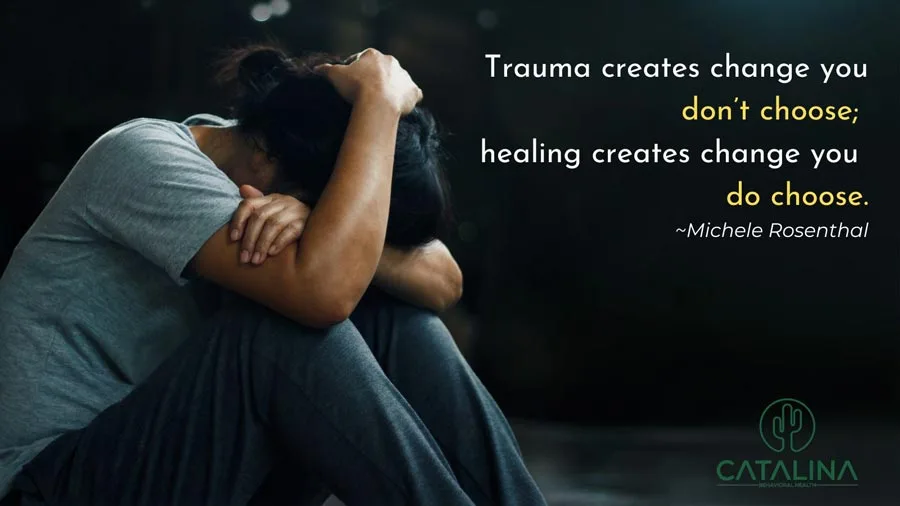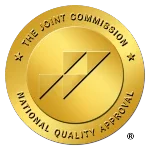Looking at the Process for Recovery from Trauma Disorders
Post-traumatic stress disorder (PTSD) can cause tremendous harm and disruption in the lives of those who live with it. Many trauma survivors suffer from a decline in mental and physical health, requiring professional care to learn coping skills to overcome the traumatic event.
Treatment is possible and well worth the effort it takes to leave the trauma symptoms behind. But it does take effort to work through the 4 stages of trauma recovery.
Most people in Tucson know Catalina Behavioral Health as a respected leader in drug and alcohol recovery. But what’s lesser known about our facility is that we have our team has also led the trauma recovery process for many. We are often called the best place to start your trauma-healing journey in Tucson and across Arizona.
Please continue to read and learn about the stages of the trauma-healing recovery process and how Catalina’s support can help minimize the impact of PTSD in your life.
Confidential Trauma and PTSD Assessment – Call Now!
The 4 Stages of Trauma Recovery for Healing Post-Traumatic Stress Disorder
The four-stage model for trauma recovery is an update to the three-phase trauma framework developed by Dr. Judith Herman and published in her book Trauma and Recovery in 1992. The three-phase recovery process was a solid framework, but today’s model applies an additional step to bring a closure phase to the trauma recovery journey.
Note that we describe the four phases below in a general way. Each person will experience trauma differently; this is a broad overview of healing from trauma in a healthy and productive way.
If you need trauma therapy, please call us to discuss your specific needs. Our team of caring professionals will create a personal growth and healing plan to suit your specific trauma symptoms.
Stage 1: Creating a Safe and Supportive Environment

The first stage of trauma recovery restores a sense of safety and stability to the person struggling with the traumatic memories, whether involving childhood trauma, adult trauma, or both. They may have intense emotions and symptoms to manage. Creating safety is key to successful recovery, as the person must have a secure environment.
They must have this support system in place before they can learn the coping strategies that will help them process the relived traumatic experiences.
An Example of Creating Emotional Support
‘Jonathan’ survived a natural disaster in the form of wildfires that took his home and nearly his life. The first responders found him in a state of shock so severe he could not speak. They worked quickly and calmly, reassuring him that he was now in safe hands. After he was safely inside the ambulance, Jonathan started nodding in response to their questions.
This communication reassured the EMTs that he had no physical injuries. Jonathan became communicative and agreed to go to the emergency room for a more thorough check-up of his mental and physical health. As he struggled to come to terms with the symptoms and traumatic memories kept recurring, Jonathan joined our outpatient mental health IOP and worked to process the events.
He is now nearly free of intrusive thoughts and flashbacks from the event and speaks about his experience often to encourage others to seek support.
Stage 2: Processing Traumatic Memories and Events
Next, the people start remembering the traumatic events to make sense of what has happened to them. Some describe this as a time of remembrance and mourning. They acknowledge the trauma and grieve for the losses that resulted from it.
This phase helps those impacted by a traumatic incident make sense of the impact the trauma may have on them, perhaps for the rest of their life.
An Example of Processing Traumatic Events
‘Hailey’ was struck by a motorist while riding her bicycle to work one day. She had frequent flashbacks afterward, replaying the impact in her mind. In trauma recovery therapy, she grieved the loss of her sense of safety and acknowledged her fears.
Over time, she began to feel safe and confident again. She eventually grew brave enough to consider hopping back onto her bicycle.
Stage 3: Reintegration into Everyday Life

While progressing through the stages of trauma recovery, the person begins to see mental health improvements. They will feel ready for reconnection and integration with their everyday life. They spend time restoring relationships and redeveloping self-confidence.
They also work on integrating the traumatic experiences into their life story and learn to live with it.
An Example of the Reintegration Stage of Trauma Recovery
‘Benson’ was robbed while leaving a neighborhood convenience store one night. The assailants punched them in the face and stole their wallet.
After months of outpatient therapy, Benson became more comfortable leaving their house alone again. They became confident enough to return to that store when they needed something instead of going miles away from it to avoid memories of the trauma.
Stage 4: Closure and Post-Traumatic Growth
The final stage helps the person commit to self-growth after the trauma. Traumatic events can turn a person’s world upside down, leaving them in a state of disorder and often with hypervigilance. Post-traumatic growth might mean setting new goals, starting a new career, or finding new friends. This stage is highly individual, depending on the trauma.
An Example of Growth While Healing From Trauma
‘Emma’ had spent over a year in trauma therapy after a workplace accident left her with limited use of her right arm. While physical therapy had helped her regain what physical strength was possible, she could not shake free of the traumatic event. She had come to terms with the negative emotions she’d felt after the accident and was ready to enter the workforce again.
Knowing she could not return to her former job, Emma enrolled in a job retraining program, planning for a career where she could thrive with her new, different abilities.
Why This 4-Stage Recovery Process Works
The four-stage healing process is very effective because it follows a structured path forward while also taking a holistic look at trauma and its impact on someone’s life.
Following the four stages of trauma recovery allows for high program customization and the flexibility needed to address a host of possible client needs.
The Physical and Emotional Symptoms of Trauma (PTSD)

Do you have depression, anxiety, or other mental health issues and believe they come from trauma? Here are the mental and physical health symptoms of untreated PTSD:
- Emotional numbness
- Flashbacks
- Nightmares or sleep disruptions
- Impossible-to-manage, intense emotions
- Avoidance behaviors
- Overly watchful or feeling on edge; hypervigilance
- Intrusive thoughts
- Depression
- Social isolation
- Increased anxiety
These signs can point to a traumatic past, including the possibility of childhood trauma, neglect, or a young adulthood that lacked a healthy support system.
However, it’s also noteworthy that PTSD often overlaps with other common mental health conditions. It’s always wise to seek professional guidance to get an accurate diagnosis.
Get Effective Trauma Treatment Options – Reach Out Now!
A Traumatic Event Impacted Annie’s Mental Health
‘Annie’ survived a sexual assault by a family friend as a teenager. She was only 14 and had not developed the common coping mechanisms that adults might have. She feared blame if she told her parents about the attack and remained silent.
Without the help of a mental health professional, the psychological trauma continued to spiral. Annie was drinking alcohol by age 15 and using meth by 17. She carried shame about the attack and despised her own body. Drinking and using drugs was her way to erase the painful memories through self medicating.
Annie became homeless at 18; her out-of-control antics were just too much for her frustrated parents to handle. An arrest for petty theft at 19 got her a chance at a court-ordered drug rehab program. It turned out that the drug addiction actually healed with trauma treatment.
Addressing Trauma as an Underlying Cause of Substance Abuse
With a supportive environment and new coping strategies, Annie flourished. She separated her negative beliefs about herself and finally understood that her attacker was at fault for his own behavior. That understanding set her free.
Today, Annie has a balanced life. She still goes to SMART Recovery support groups once a week to continue to stay drug-free. She’ll never forget the trauma and sometimes feels faint pangs of those familiar triggers. Regardless, she’s attending U of A to become a licensed social worker and hopes to start helping trauma survivors like herself.
Using a Trauma-informed Approach to the Healing Process

The trauma recovery process can, at times, feel uncomfortable to survivors. Regardless of the ongoing challenges after trauma occurs, the healthy coping mechanisms developed are a reward worth the discomfort.
Trauma recovery involves the nervous system; therapies that help someone process a traumatic event regulate and recondition nervous responses to trauma triggers.
The therapies below are a few tools we have at Catalina. Each client receives a custom-tailored PTSD recovery program, including individual therapy and support groups. Many also participate in holistic activities like music or art therapy.
With the help of a therapist, clients develop emotional regulation and better coping strategies that will help them move forward after trauma.
Dialectical Behavior Therapy
Dialectical behavior therapy (DBT) helps people manage the most intense emotions associated with their trauma while also helping them develop coping strategies to minimize the impact of the traumatic event. It focuses on emotional regulation, distress tolerance, and being a better communicator.
Cognitive Behavioral Therapy
Cognitive behavioral therapy (CBT) helps clients identify negative emotions and thought patterns and challenge those thoughts. It addresses the distorted thoughts that are a frequent part of the trauma response and leads clients back to more rational, healthier behaviors.
Eye Movement Desensitization
Eye movement desensitization (EMDR) therapy asks clients to recall their traumatic memories as they follow certain eye movements. EMDR therapy helps promote healing by reducing the trauma’s emotional impact on the client.
Exposure Therapy
As the name suggests, exposure therapy gradually and repeatedly exposes clients to their fears or traumatic events in a safe, therapeutic setting. When they address their triggers head-on, they can master a more measured, appropriate response.
Catalina Behavioral Health and Our Trauma Recovery Programs
If you are deciding whether you need professional help with trauma recovery, it’s helpful to know the factors that help determine whether you’re a good candidate for inpatient/residential or whether outpatient services would better benefit you.
Catalina offers a choice of inpatient or outpatient care options to help clients recover from trauma. The level of care necessary depends on:
- The trauma’s severity: The intensity of one’s flashbacks, nightmares, or emotional outbursts help determine the best treatment type. The most severe PTSD may require inpatient treatment.
- Co-occurring disorders: Trauma and PTSD can also mean the development of additional mental health disorders. These can include substance use disorder, depression, or anxiety. Co-occurrences of other mental health challenges could make inpatient care a better option.
- Client’s daily functionality: Some people feel the impact of trauma in their lives but muddle through despite the disruptions. Others find the traumatic memories taking over their lives and can barely manage to get through the day. Outpatient treatment services are more effective in those with higher daily functioning.
- Access to a support network: People who do not have a caring, supportive network outside of the treatment facility may not make progress as quickly as clients with a supportive home environment. Outpatient treatment is better suited for those who have a stable home life to return to after leaving therapy each day.
You don’t need to decide the level of care on your own. Our team is ready to help you make an informed decision about getting help for trauma or other mental health issues. We are happy to guide you throughout the process.
We Work With Most Major Insurance Companies

Our PTSD treatment program accepts most major insurance programs. Whether you have a private health plan, group health insurance, or Arizona Medicaid (AHCCCS), we accept many forms of benefits.
Our admissions staff will be glad to verify your benefits and level of coverage before you arrive at our facility. We want you to focus on healing your mental health condition without fear of the financial burden.
Up To 100% of Rehab Costs Covered By Insurance
Connect with Catalina for Help Processing Trauma
If you need assistance with trauma recovery for yourself or someone you love, feel free to reach out to the professional, compassionate team at Catalina Behavioral Health. Our staff can help you develop the key coping skills following the four stages of trauma model.
The result will be a healing process that gives you lasting results and a sense of relief.
It’s time to let go of that traumatic event and start healing today. Seek professional care – give Catalina a confidential call today.




